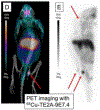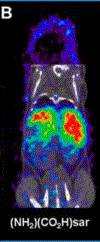Methods for the Production of Radiolabeled Bioagents for ImmunoPET
- PMID: 38006494
- PMCID: PMC11330323
- DOI: 10.1007/978-1-0716-3499-8_8
Methods for the Production of Radiolabeled Bioagents for ImmunoPET
Abstract
Immunoglobulin-based positron emission tomography (ImmunoPET) is making increasingly significant contributions to the nuclear imaging toolbox. The exquisite specificity of antibodies combined with the high-resolution imaging of PET enables clinicians and researchers to localize diseases, especially cancer, with a high degree of spatial certainty. This review focuses on the radiopharmaceutical preparation necessary to obtain those images-the work behind the scenes, which occurs even before the patient or animal is injected with the radioimmunoconjugate. The focus of this methods review will be the chelation of four radioisotopes to their most common and clinically relevant chelators.
Keywords: 124I; 64Cu; 86Y; 89Zr; ImmunoPET; antibody radiolabeling; chelator; radioimmunoconjugate.
© 2024. The Author(s), under exclusive license to Springer Science+Business Media, LLC, part of Springer Nature.
Figures











Similar articles
-
Diagnostic Positron Emission Tomography Imaging with Zirconium-89 Desferrioxamine B Squaramide: From Bench to Bedside.Acc Chem Res. 2024 May 7;57(9):1421-1433. doi: 10.1021/acs.accounts.4c00092. Epub 2024 Apr 26. Acc Chem Res. 2024. PMID: 38666539
-
The bioconjugation and radiosynthesis of 89Zr-DFO-labeled antibodies.J Vis Exp. 2015 Feb 12;(96):52521. doi: 10.3791/52521. J Vis Exp. 2015. PMID: 25741890 Free PMC article.
-
Evaluation of a 3-hydroxypyridin-2-one (2,3-HOPO) Based Macrocyclic Chelator for (89)Zr(4+) and Its Use for ImmunoPET Imaging of HER2 Positive Model of Ovarian Carcinoma in Mice.Theranostics. 2016 Feb 13;6(4):511-21. doi: 10.7150/thno.14261. eCollection 2016. Theranostics. 2016. PMID: 26941844 Free PMC article.
-
Radiochemistry, Production Processes, Labeling Methods, and ImmunoPET Imaging Pharmaceuticals of Iodine-124.Molecules. 2021 Jan 14;26(2):414. doi: 10.3390/molecules26020414. Molecules. 2021. PMID: 33466827 Free PMC article. Review.
-
Chelators for copper radionuclides in positron emission tomography radiopharmaceuticals.J Labelled Comp Radiopharm. 2014 Apr;57(4):224-30. doi: 10.1002/jlcr.3165. Epub 2013 Dec 18. J Labelled Comp Radiopharm. 2014. PMID: 24347474 Free PMC article. Review.
Cited by
-
Advances and challenges in precision imaging.Lancet Oncol. 2025 Jan;26(1):e34-e45. doi: 10.1016/S1470-2045(24)00395-4. Lancet Oncol. 2025. PMID: 39756454 Free PMC article. Review.
-
Targeting Extra Domain A of Fibronectin to Improve Noninvasive Detection of Triple-Negative Breast Cancer.J Nucl Med. 2025 Jun 2;66(6):880-885. doi: 10.2967/jnumed.124.268859. J Nucl Med. 2025. PMID: 40246542
References
-
- Ljungars A, Martensson L, Mattsson J, Kovacek M, Sundberg A, Tornberg UC, Jansson B, Persson N, Emruli VK, Ek S, Jerkeman M, Hansson M, Juliusson G, Ohlin M, Frendeus B, Teige I, Mattsson M (2018) A platform for phenotypic discovery of therapeutic antibodies and targets applied on Chronic Lymphocytic Leukemia. NPJ Precis Oncol 2:18. doi:10.1038/s41698-018-0061-2 - DOI - PMC - PubMed
-
- Sundaresan G, Yazaki PJ, Shively JE, Finn RD, Larson SM, Raubitschek AA, Williams LE, Chatziioannou AF, Gambhir SS, Wu AM (2003) 124I-labeled engineered anti-CEA minibodies and diabodies allow high-contrast, antigen-specific small-animal PET imaging of xenografts in athymic mice. J Nucl Med 44 (12):1962–1969 - PMC - PubMed
-
- Lepin EJ, Leyton JV, Zhou Y, Olafsen T, Salazar FB, McCabe KE, Hahm S, Marks JD, Reiter RE, Wu AM (2010) An affinity matured minibody for PET imaging of prostate stem cell antigen (PSCA)-expressing tumors. Eur J Nucl Med Mol Imaging 37 (8):1529–1538. doi:10.1007/s00259-010-1433-1 - DOI - PMC - PubMed
-
- Pandit-Taskar N, Postow MA, Hellmann MD, Harding JJ, Barker CA, O'Donoghue JA, Ziolkowska M, Ruan S, Lyashchenko SK, Tsai F, Farwell M, Mitchell TC, Korn R, Le W, Lewis JS, Weber WA, Behera D, Wilson I, Gordon M, Wu AM, Wolchok JD (2020) First-in-Humans Imaging with (89)Zr-Df-IAB22M2C Anti-CD8 Minibody in Patients with Solid Malignancies: Preliminary Pharmacokinetics, Biodistribution, and Lesion Targeting. J Nucl Med 61 (4):512–519. doi:10.2967/jnumed.119.229781 - DOI - PMC - PubMed
Publication types
MeSH terms
Substances
Grants and funding
LinkOut - more resources
Full Text Sources
Medical

